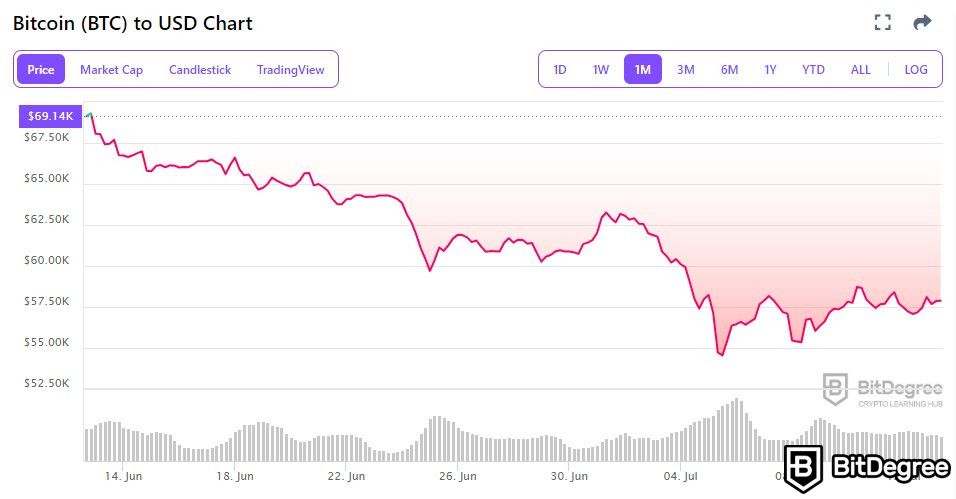Key Takeaways
- Cryptocurrency prices are influenced by a variety of factors including regulatory crackdowns, market sentiment, technological issues, and macroeconomic conditions.
- Major events such as security breaches, whale movements, and market manipulation can cause significant volatility in the crypto market.
- Understanding the environmental impact and technological advances in traditional finance is crucial for navigating the reasons behind why is crypto down.
Stop overpaying - start transferring money with Ogvio. Sign up, invite friends & grab Rewards now! 🎁
At the time of writing this article, the crypto market has been experiencing a notable downtrend since early July 2024. You might have checked your favorite exchange – be it Binance, Kraken, or Bybit – and noticed a slump, wondering: "Why is crypto down today?" Well, you've come to the right place!
In this article, I will discuss the potential reasons behind the recent cryptocurrency downtrend and briefly go over what this may indicate for the overall cryptocurrency market. Additionally, I will also present 10 common causes of a cryptocurrency downtrend to answer the question "Why is cryptocurrency crashing?" and prepare you with the necessary knowledge to understand crypto price changes.
The cryptocurrency market is still highly volatile and the ability to recognize signs of corrections is important to properly navigate through it. So, without further ado, let’s figure out why is crypto down.

Did you know?
Subscribe - We publish new crypto explainer videos every week!
How to Trade NFTs Safely? (Animated Explainer For Beginners)


Table of Contents
- 1. Why is Crypto Down? The 2024 Downtrend
- 1.1. Potential Impacts on the Overall Crypto Market
- 2. Common Causes of a Cryptocurrency Downtrend
- 2.1. Regulatory Crackdowns
- 2.2. Market Sentiment
- 2.3. Technological Issues
- 2.4. Macroeconomic Factors
- 2.5. Speculative Bubbles
- 2.6. Whale Movements
- 2.7. Market Manipulation
- 2.8. Security Concerns
- 2.9. Technological Advances in Traditional Finance
- 2.10. Environmental Concerns
- 3. Conclusions
Why is Crypto Down? The 2024 Downtrend
As I mentioned earlier, there has been a downtrend in the crypto market for some time now. To help answer “Why is crypto down today?”, we need to examine a series of events that happened in recent months. First of all, Bitcoin (BTC) has fallen below its key 200-day moving average, which is often seen as a sign of a bear market. The coin’s value dropped below $58,000 on July 4, hitting its lowest point since early May.
Latest Deal Active Right Now:According to experts, there are several potential causes of this downtrend. Here are some of the notable ones:
- U.S. economic uncertainty: investor sentiment has been impacted by recent remarks from Federal Reserve chair Jerome Powell, which reduced expectations for interest rate cuts in 2024. Concerns about inflation and interest rates may have led to increased caution among investors, contributing to the market's downward trend.
- Chinese regulatory announcements: new regulations on Bitcoin trading announced by Chinese authorities have also added to the market's volatility. Historically, regulatory news from China has had a significant impact on the crypto market, and the latest announcements have continued this trend.

- Mt. Gox repayments: the upcoming $9.6 billion worth of BTC repayments to creditors of the long-defunct crypto exchange Mt. Gox adds significant selling pressure to the market.
- Institutional activity: reports of institutional investors purchasing Bitcoin have provided some stability, but have not been enough to counteract the overall negative sentiment. Net outflows from spot Bitcoin ETFs have further pressured prices downward.
- Market technicals: from a technical standpoint, the market has seen significant corrections. Key support levels have been breached, and the overall market structure points to potential further declines if bearish trends continue.
These combined factors have led to a significant decrease in market capitalization, with Bitcoin prices falling from $63,064 to $54,550 between July 2 and July 5, 2024. The overall crypto market dropped by over 5.7%, with continued sell-offs expected if conditions persist.
Potential Impacts on the Overall Crypto Market
Now you might wonder, "How will this current crypto downtrend affect the overall market condition?" To address this, let's examine several implications based on the recent crypto crash:
- Increased volatility: the crypto market is likely to experience heightened volatility in the short term. Factors such as economic uncertainty in the U.S. and regulatory actions from countries like China are causing fluctuations, making the market unpredictable.
- Investor caution: with the Federal Reserve's cautious stance on interest rate cuts and regulatory crackdowns, investors may adopt a more cautious approach. This could lead to reduced trading volumes and potentially further sell-offs as traders look to de-risk their portfolios.
- Potential for further declines: technical indicators suggest that if key support levels are breached, the market could see further declines. For instance, Bitcoin might fall to the $50,000 range if macroeconomic conditions do not improve.

- Impact on market sentiment: negative sentiment could dominate the market, influenced by macroeconomic signals and ongoing regulatory developments. This may deter new investments and slow down the market's recovery.
- Long-term outlook: despite short-term challenges, the long-term trajectory of the crypto market will depend on broader economic conditions and regulatory clarity. Investors need to stay informed and vigilant, balancing risks with potential rewards in this dynamic environment.
So, if you are wondering: “Why is crypto crashing and will it recover?” the answer is honestly not straightforward. To put it as simply as possible, while the current downtrend presents challenges, the crypto market's future will be shaped by how these macroeconomic and regulatory factors evolve.
Common Causes of a Cryptocurrency Downtrend
Understanding the "why" behind a crypto downturn can be tricky. While some events are specific to certain coins, many factors contribute to a broader market correction. Let's delve into the 10 most common reasons why the cryptocurrency market might be experiencing a dip.
Regulatory Crackdowns
One of the most significant factors explaining why is crypto down often revolves around regulatory changes and crackdowns. Governments and regulatory bodies across the globe have been tightening their grip on cryptocurrency trading and operations, leading to considerable market fluctuations.
Take Binance, for instance. In the past couple of years, Binance has faced increased scrutiny from regulators worldwide. The U.K. Financial Conduct Authority (FCA) banned Binance Markets Limited from conducting any regulated activity in the UK. This caused panic among investors, resulting in a sharp decline in Binance Coin (BNB) and other cryptocurrencies. The uncertainty and fear surrounding such regulatory actions answer the recurring question, "Why is crypto down?".

Similarly, Kraken wasn't spared from regulatory woes. In early 2023, Kraken agreed to shut its cryptocurrency staking services and pay a $30 million settlement to the U.S. Securities and Exchange Commission (SEC). This move led to a noticeable dip in market prices as investors reevaluated the future of staking and the broader implications of the SEC's stance.
Bybit also faced its share of challenges. The exchange announced it would stop serving UK customers following a ban on derivatives trading by the FCA. Such decisions impact market sentiment significantly, contributing to why is crypto crashing at times when these announcements are made.
When major exchanges like Binance, Kraken, and Bybit are forced to alter their operations or exit markets due to regulatory pressures, it shakes investor confidence. The fear of further crackdowns and the resulting uncertainty can lead to sharp sell-offs, driving down prices across the board. This regulatory landscape continues to be a critical factor in the volatility of the crypto market.
Market Sentiment
Another key factor in understanding why is crypto down is market sentiment. This intangible yet powerful force drives investor behavior and can swing prices dramatically. Market sentiment is essentially how investors feel about the market at a given time, influenced by news, social media, and broader economic conditions. There is also evidence that the sentiment of the dominant cryptocurrency, like Bitcoin, influences the price of other cryptocurrencies[1].
Take the infamous crypto crash of May 2021, for example. Tesla CEO Elon Musk tweeted concerns about Bitcoin's environmental impact, leading to a massive sell-off. This single tweet sparked fear and doubt among investors, contributing significantly to why is crypto down. When influential figures express negative opinions, it can create a domino effect, causing panic and leading to sharp price drops.

Another instance is the collapse of FTX in November 2022. News of its bankruptcy and the subsequent fallout spread rapidly, shaking the confidence of investors across the globe. This event answered the question of why is crypto falling during that period, as trust in the market took a significant hit.
Social media platforms like Twitter and Reddit also play a crucial role in shaping market sentiment. Positive buzz can drive prices up, while negative news or rumors can lead to dramatic declines. For example, speculation about tighter regulations or the banning of crypto transactions in major economies often triggers widespread fear, causing investors to sell off their assets.
Understanding market sentiment is crucial for any crypto investor. It highlights how emotional and psychological factors can significantly impact the market, often explaining why is crypto down at unexpected times. Being aware of these influences and keeping up with the recent crypto news can help in making more informed investment decisions.
Technological Issues
Have you ever wondered why is crypto down even when there’s no major news or regulatory crackdown? Sometimes, the answer lies in technological issues. These can range from network congestion to security breaches, and they often lead to significant price drops.
Take, for example, the Ethereum network. In September 2020, the DeFi boom led to massive congestion on the Ethereum blockchain, resulting in sky-high transaction fees and slower processing times. This frustration among users and investors contributed to why is crypto going down during that period. When a major blockchain like Ethereum faces technical issues, it shakes the confidence of investors, leading to a sell-off.

Security breaches are another major factor. Remember the infamous Mt. Gox hack in 2014? The exchange lost about 850,000 Bitcoins, causing panic and a significant drop in Bitcoin’s price. More recently, in 2021 and 2023, the Poly Network hack resulted in a loss of over $600 million. Such breaches make headlines and spread fear, answering why is crypto down during these periods of turmoil.
Even planned technological updates can cause uncertainty. The anticipation and execution of Bitcoin’s Taproot upgrade in November 2021 led to price volatility. While upgrades are intended to improve the network, the fear of potential issues during implementation can lead to temporary declines.
So, next time you find yourself asking why is crypto down, consider the technological aspects. Network congestion, security breaches, and even upgrades can all play a part in these fluctuations. Staying informed about the technological health of the networks you're invested in can help you navigate these turbulent waters better.

Did you know?
Subscribe - We publish new crypto explainer videos every week!
Toobit Tutorial For Beginners (FULL Animated 2025 Guide)


Macroeconomic Factors
Sometimes, the reason why crypto is down has nothing to do with blockchain or the crypto market itself, rather, the source lies within the macroeconomy. These are the big-picture economic events and trends that can have a massive impact on the cryptocurrency market.
Let's take a look at inflation. In 2022, rising inflation rates led to fears of reduced purchasing power and increased living costs. This economic pressure forced many investors to liquidate their crypto holdings to cover day-to-day expenses, which is a key reason why is crypto down during high inflation periods. When people need cash, their riskier investments are often the first to go.

Interest rates also play a crucial role. When central banks, like the Federal Reserve in the U.S., hike interest rates, it makes borrowing more expensive and saving more attractive. In 2022, the Fed's aggressive rate hikes caused a significant downturn in the crypto market. Investors shifted their funds from high-risk assets like cryptocurrencies to safer, interest-bearing accounts, contributing to why is crypto down during such times.
Global economic instability can’t be ignored either. The COVID-19 pandemic in 2020 triggered one of the most volatile periods in financial history. Stock markets crashed, and so did the crypto market. The initial panic led many to ask, "Why is crypto crashing and will it recover?" Although it eventually bounced back, the initial reaction was a massive sell-off driven by fear and uncertainty.
So, when trying to figure out why is crypto down, it's essential to look at the broader economic landscape. Inflation, interest rates, and global crises can all have a profound effect on the market. Understanding these factors can provide a clearer picture of the forces at play and help you make more informed investment decisions.
Speculative Bubbles
Speculative bubbles are another major reason why crypto is down at times. These bubbles form when the price of a cryptocurrency is driven to unsustainable highs by excessive market speculation. Eventually, these bubbles burst, leading to dramatic price drops. Evidently, bubbles are more prone to emerge in the crypto market than in other similar landscapes like the stock markets[2].
Remember the Bitcoin bubble of 2017? Bitcoin’s price soared to nearly $20,000 in December 2017, fueled by a frenzy of speculation. Everyone was talking about Bitcoin, and it seemed like the price would only keep going up. However, this was a classic speculative bubble. By early 2018, the bubble burst, and Bitcoin’s price plummeted to around $6,000. This drastic fall left many asking, “Why is crypto down so much?”

The same pattern repeated with the rise and fall of Dogecoin in 2021. Initially created as a joke, Dogecoin’s price skyrocketed thanks to social media hype and celebrity endorsements, notably from Elon Musk. At its peak in May 2021, Dogecoin hit $0.73, but by July, it had dropped to around $0.20. The hype couldn't sustain the price, illustrating why is crypto down when speculation overtakes actual value.
These speculative bubbles are often driven by FOMO (fear of missing out), where investors rush to buy in, hoping to make quick profits. However, when the excitement fades and reality sets in, prices come crashing down. This leads to widespread panic selling, leaving many wondering, “Why is crypto crashing?”
So, next time you notice significant price drops, consider the role of speculative bubbles. These periods of intense hype followed by sharp declines are a common reason why is crypto down. Staying cautious during such times can help you avoid the pitfalls of speculative investments.
Whale Movements
Another intriguing factor behind why is crypto down can be traced to the movements of crypto whales. Whales are individuals or entities that hold large amounts of a particular cryptocurrency. When these whales make significant transactions, it can lead to considerable market fluctuations.
Imagine this: you're keeping an eye on Bitcoin, and suddenly, its price takes a nosedive. What happened? It could be that a whale decided to sell off a substantial amount of Bitcoin. For instance, in September 2021, a single wallet transferred 31,000 Bitcoins to an exchange. This massive movement caused panic, and Bitcoin's price dropped by about 8% in just a few hours. Events like these often leave many asking, "Why is crypto down?".

Another notable example involves the infamous Mt. Gox trustee. In 2018, the trustee sold large amounts of Bitcoin and Bitcoin Cash to repay creditors, leading to significant price drops. Every time these large sell-offs occurred, the market reacted with fear and uncertainty, further explaining why is crypto down during these periods.
Whale movements aren't limited to selling; even large purchases can cause volatility. When a whale buys a significant amount of a particular crypto coin, it can drive the price up, only to potentially fall again when the same whale decides to cash out. This constant fluctuation leads to questions like "Why is crypto crashing and will it recover?"
So, if you see sudden, unexplained drops in crypto prices, whale movements might be the culprit. These large holders can create waves in the market, causing prices to rise and fall rapidly. Understanding the impact of whale movements can help you navigate the crypto market's unpredictable waters and make more informed investment decisions.
Market Manipulation
One major downside of the lack of regulations in the crypto market is the high risk of market manipulation. This involves deceptive practices by individuals or groups to artificially inflate or deflate cryptocurrency prices for personal gain.
One common form of market manipulation is the "pump-and-dump" scheme. Here’s how it works: manipulators buy large amounts of a cryptocurrency, hype it up through social media or other channels to drive up the price, and then sell off their holdings at the peak. This leaves ordinary investors holding the bag when the price crashes.

For example, in early 2021, several lesser-known altcoins experienced rapid price spikes followed by steep declines; classic signs of pump-and-dump schemes. This phenomenon often leaves investors scratching their heads and asking, "Why is crypto down?"
Another instance is the use of fake trading volumes to create an illusion of demand. In 2019, a Bitwise report revealed that nearly 95% of Bitcoin trading volume reported on unregulated exchanges was fake. This manipulation can significantly impact prices, creating volatility and uncertainty, which explains why is crypto falling unexpectedly.
Spoofing is yet another tactic where manipulators place large buy or sell orders to create the illusion of demand or supply, only to cancel these orders before they are executed. This can mislead other traders and move the market in a desired direction. In 2020, the U.S. Department of Justice charged multiple individuals for spoofing in the cryptocurrency market, highlighting the ongoing issue of market manipulation.
Understanding these deceptive practices helps explain why is crypto down at times when it seems irrational. Recognizing the signs of market manipulation can protect you from falling victim to these schemes and help you make more informed trading decisions.
Security Concerns
Security concerns are a significant reason behind sudden drops in cryptocurrency prices. When investors lose confidence in the safety of their assets, they often rush to sell, leading to sharp declines.
Take the infamous Mt. Gox hack in 2014 as an example. The exchange, which handled about 70% of all Bitcoin transactions at the time, lost 850,000 Bitcoins due to a security breach. This catastrophic event caused Bitcoin’s price to plummet from over $800 to around $400 in a matter of days. Investors were left wondering why crypto is falling so drastically.

More recently, in 2021, the Poly Network hack resulted in a loss of over $600 million in various cryptocurrencies. Although the hacker eventually returned most of the funds, the immediate reaction was one of panic. The value of the affected cryptocurrencies dropped significantly as investors feared further breaches. This incident answered the question of why is crypto down during that period.
Even smaller security issues can impact the market. For instance, when Tether, the stablecoin issuer, revealed in 2019 that it had been hit by a $31 million hack, it caused a ripple effect across the crypto market. Trust in the stability of Tether wavered, leading to temporary price declines.
These security concerns highlight the fragility of the crypto market. Whenever a major breach occurs, it shakes investor confidence, leading to quick sell-offs and significant price drops. Understanding these vulnerabilities helps explain why crypto is down at times and underscores the importance of robust security measures in the crypto ecosystem.
Technological Advances in Traditional Finance
Even though we can agree that cryptocurrency has the potential to be the future of finance, it doesn’t mean that traditional finance is stopping improving. As conventional financial systems evolve and integrate cutting-edge technology, they sometimes draw attention and investment away from cryptocurrencies.
Consider the rise of Central Bank Digital Currencies (CBDCs). When China launched its digital yuan pilot in 2020, it sparked significant interest. The digital yuan offered a state-backed alternative to cryptocurrencies, leading some investors to reconsider their positions in crypto. The announcement and subsequent adoption of CBDCs in other countries caused a noticeable dip in the crypto market. Investors were asking, “Why is crypto going down?” as funds shifted towards these new, more stable digital assets.

Another example is the growth of fintech companies like PayPal and Square. When PayPal announced in 2020 that it would allow users to buy, sell, and hold cryptocurrencies, it initially boosted the market. However, as these platforms started integrating crypto more seamlessly into traditional finance, some investors began seeing less need for decentralized exchanges. This shift contributed to why is crypto down during periods when fintech adoption surged.
Blockchain technology has also been increasingly adopted by traditional financial institutions. For instance, JP Morgan’s blockchain platform, Onyx, introduced advanced financial products using blockchain without the volatility associated with cryptocurrencies. This technological progress in traditional finance diverted attention and funds from the more volatile crypto market, explaining why is crypto down during these advancements.
So, when considering why is crypto down, it's essential to look at how technological advances in traditional finance are influencing investor behavior. These innovations can provide more stable and integrated alternatives, leading to temporary declines in the crypto market.

- Secure and reliable
- Accepts fiat currencies
- Lots of trading options
- Reputable exchange
- Accepts fiat currencies
- Offers various trading options

- Huge trading variety
- Regulation-compliant around the globe
- Fair trading fees
- Beginner-friendly
- A wide array of features
- Vast number of different crypto coins & tokens

- Beginner-friendly
- Secure
- Decent trading and withdrawal fees
- Crypto.com Visa Card
- Automated tools & bots
- Ecosystem synergy with CRO
Environmental Concerns
Environmental concerns have become a significant factor affecting cryptocurrency prices, particularly for energy-intensive cryptocurrencies like Bitcoin.
A prime example is Elon Musk’s announcement in May 2021. Musk tweeted that Tesla would stop accepting Bitcoin payments due to concerns over Bitcoin's environmental impact, specifically its high energy consumption. This single tweet sent shockwaves through the crypto market, causing Bitcoin’s price to drop by around 15% within hours. Investors were left asking why is crypto going down so sharply.

Another instance involves China’s crackdown on Bitcoin mining in mid-2021. Citing environmental concerns, the Chinese government shut down numerous mining operations across the country. Given that China was responsible for a substantial portion of the global Bitcoin hash rate, this crackdown significantly disrupted the network and led to a sharp decline in Bitcoin’s price. The market reacted swiftly, with Bitcoin losing nearly 30% of its value over a few weeks. These events provide a clear answer to why is crypto down during such times.
Additionally, ongoing debates about the carbon footprint of cryptocurrencies continue to impact market sentiment. As more investors and companies prioritize environmental sustainability, the high energy consumption of proof-of-work cryptocurrencies like Bitcoin and Ethereum comes under increased scrutiny. This shift in investor priorities can lead to sell-offs, contributing to why is crypto down.
So, when pondering why is crypto down, remember that environmental concerns play a crucial role. As the world becomes more eco-conscious, the environmental impact of cryptocurrencies will likely continue to influence their market dynamics, affecting prices and investor sentiment.
Conclusions
So, why is crypto down right now? The recent downtrend in 2024 is a result of several factors we've discussed. Regulatory crackdowns have hit major exchanges like Binance, Kraken, and Bybit, causing widespread uncertainty. Market sentiment, fueled by social media and influential voices, has also played a significant role. Technological issues and macroeconomic factors add more layers to the complex puzzle of crypto volatility.
Speculative bubbles have shown us how hype can lead to dramatic rises and equally dramatic falls, leaving many wondering, "Why is crypto crashing and will it recover?" Whale movements and market manipulation further complicate the landscape, often driving prices down without warning.
Security concerns remain a persistent issue, with hacks and breaches shaking investor confidence. Meanwhile, technological advances in traditional finance offer more stable alternatives, drawing funds away from cryptocurrencies. And let's not forget the growing environmental concerns impacting how investors view energy-intensive cryptos.
Understanding these factors helps answer why is crypto falling and offers insights into the current downtrend. While the crypto market is notoriously volatile, being aware of these influences can help you navigate it more effectively. So, will it recover? Only time will tell, but staying informed and cautious can make all the difference in your crypto investment journey.
The content published on this website is not aimed to give any kind of financial, investment, trading, or any other form of advice. BitDegree.org does not endorse or suggest you to buy, sell or hold any kind of cryptocurrency. Before making financial investment decisions, do consult your financial advisor.
Scientific References
1. Anamika, Chakraborty M., Subramaniam S.: Does Sentiment Impact Cryptocurrency?;
2. Chen C.Y.-H, Hafner C.M.: Sentiment-Induced Bubbles in the Cryptocurrency Market.









